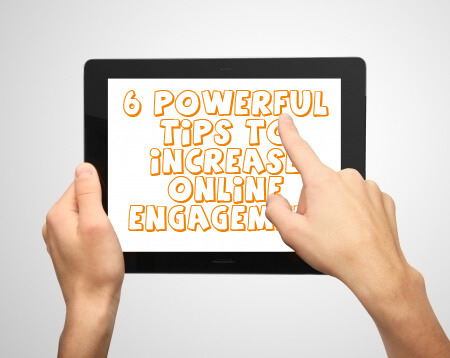These days, there are so many different ways for online engagement. It’s become such an easy task to engage…right?
Okay, not really, especially if you’re not totally clear on what works or have a purpose for participating online.
So many marketers have new, shiny object syndrome (hello, Ello?) and forget about the things that actually work.
They also want to try out the latest and greatest, but ignore whether their customers and prospects are in those places.
It’s a lot easier today to figure out where you customers and prospects hang out, particularly online.
Here are six powerful tips to increase your online engagement with your audience.
1. Get Visual
Imagine this—two online stores selling the same products for the same price.
The two websites look almost identical and also share similar online marketing strategies.
The only major thing that differentiates these two online stores is that one displays pictures of their products, while the other site only displays pictures of its logo.
Which store do you think brings in more sales?
The site without the logo pictures, of course!
Seems silly, right?
But while you already know this because you have read all about visual content here on Spin Sucks in September, not all brands are as savvy as you.
And in all seriousness, brands are still over-promoting themselves rather then their products and services.
Ditching the logo thumbnail has been shown to boost click through rate by 27 percent!
2. Don’t Forget About the Weekend
Social media is a seven-days-a-week kind of job.
Weekend posts get 32 percent more online engagement than weekday posts!
Pre-scheduling your weekend posts is a great start, but you also want to be sure to be able to reply to those engagers.
Some people don’t get around to checking their social media, (or even their emails!) until the weekend.
3. Answer Your Customer’s Questions and Use it for Content
Sometimes it’s hard to come up with engaging content that you know your audience will want to read.
Try taking some frequently asked questions and turning them into a blog series.
Chances are there are more people with the same question who aren’t reaching out to ask.
4. Be Valuable
Don’t share just to share! And be sure to read everything you’re sharing.
(I’m talking to you auto re-tweeters.)
When you share information that isn’t relevant to your audience you will become less relevant in their minds.
Content is only good when it has context.
5. Hashtag, #But #Please #Don’t #OVER #Hashtag
This is a common social media pet peeve that can lead to 17 percent decrease in followers.
Hashtags are meant to organize social conversations.
Not to hammer into the readers mind what it is you are talking about.
GOOD EXAMPLE:
@WhatRunsWhere: Transitioning your business from desktop to #mobilemarketing? Here’s how to make it happen in 4 effective ways… bit.ly/19HkD9M
BAD EXAMPLE:
@WhatRunsWhere: Transitioning your #business from #desktop to #mobilemarketing? Here’s how to make it happen in 4 effective ways… bit.ly/19HkD9M #Transitions #SoLongDesktop #mobile #marketing #whatrunswhere #CheckOutOurBlog #WeLoveMobile
Maybe this example is a little extreme, but you get the point.
Keep it to a maximum two hashtags unless absolutely necessary.
6. Make Your Online Engagement Human
No one really enjoys talking to robots.
If they did, THIS would be the answer to engaging our audiences.
When engaging with an audience online, you simply must be real.
Share relevant news, or engage in conversations.
Also, make sure everything you share on social media is actually valuable to your readers.
(I’m talking to you again, auto-retweeters.)
Don’t get me wrong—prescheduling some your social media posts using tools such as Sprout Social or Hootsuite can be a real timesaver.
However, make sure you are keeping the human element of online engagement.
Don’t be intimidated when trying to engage with your audience.
Test different methods and see what works with your audience!
Once you stop talking at your audience, and begin engaging with them, you’ll become much more valuable in their minds.
